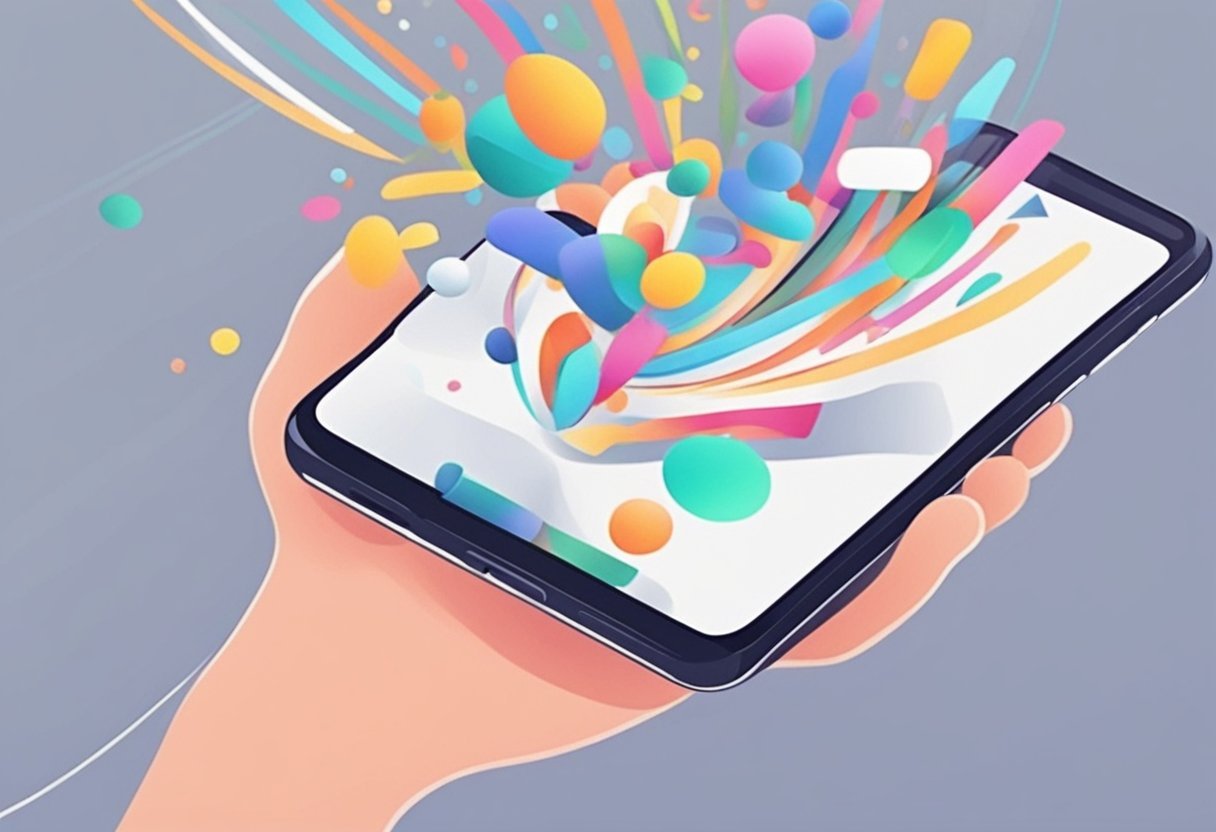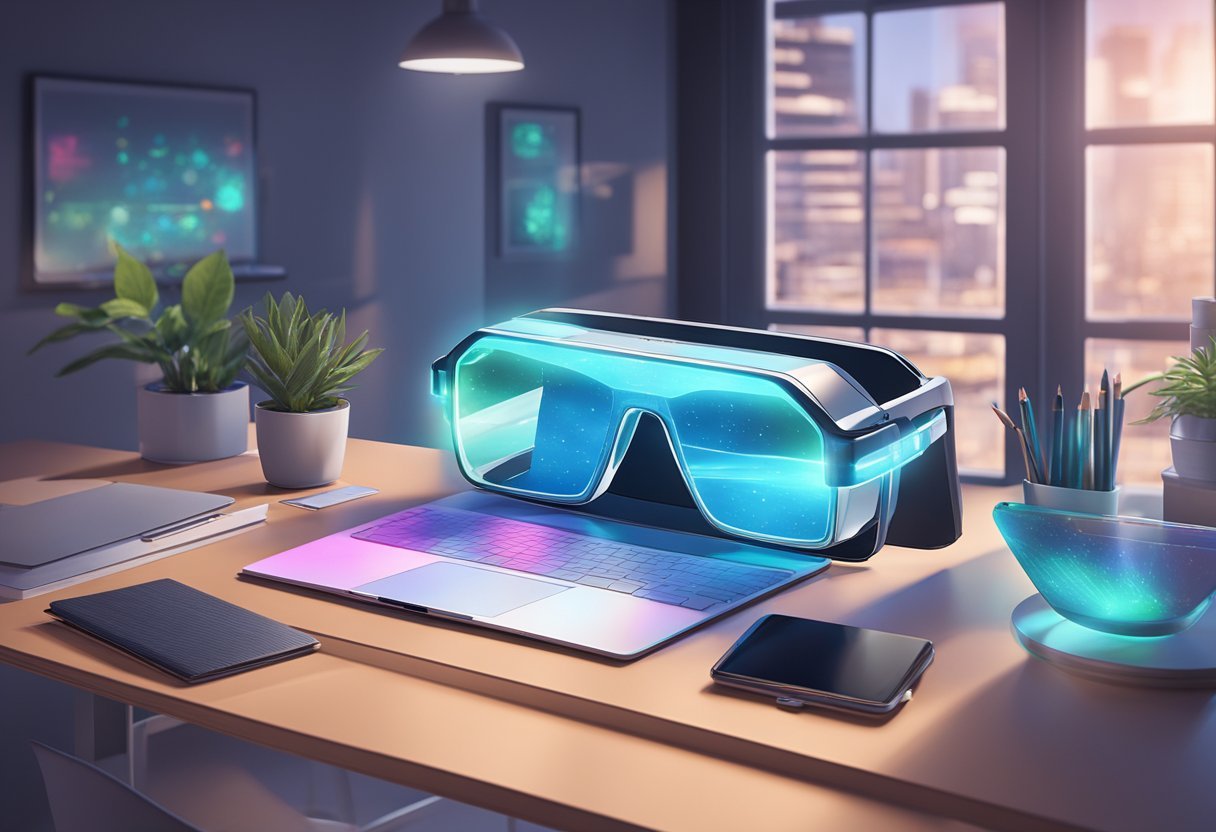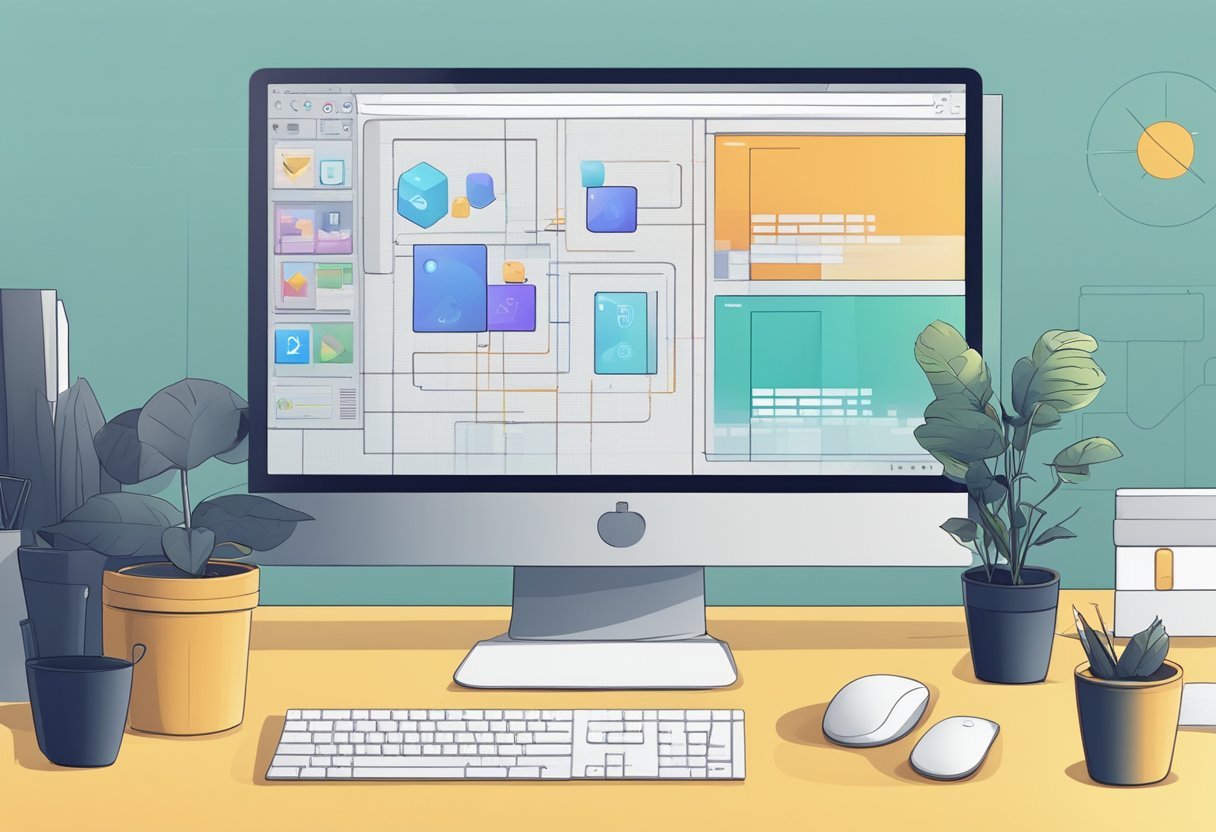Augmented reality (AR) is an interactive experience that enhances the real world with computer-generated perceptual information, including sound, video, graphics, and GPS data. AR has become increasingly popular in recent years, with many businesses and individuals using it to create engaging and immersive AR experiences. In this blog post, we will discuss creating AR. I will share with you 10 platforms you can use to create augmented reality.
Creating AR experiences can be a challenging task, but there are many tools available that make it easier than ever before. For example, Adobe Aero is a powerful AR software that allows users to build, view, and share immersive storytelling experiences in mobile AR. Reality Composer is another tool that enables users to create interactive AR experiences with no prior 3D experience.
What Is Augmented Reality
Augmented Reality (AR) is a technology that superimposes digital information on the real world. The technology has been around for many years and is gaining popularity in various industries. AR is a medium that requires technology to carry it out, and it has the potential to revolutionize many industries, from entertainment to education.
Fundamentals of AR
AR experiences are created by overlaying digital information on the real world. The technology works by using a camera-equipped device, such as a smartphone or tablet, loaded with AR software. When a user points the device at an object, the software recognizes the object and overlays digital information on it. The user can then interact with the digital information in real-time.
AR in the Real World
AR has many real-world applications. For example, it can be used in the field of medicine to create interactive 3D models of the human body. It can also be used in the field of architecture to create interactive 3D models of buildings. AR can be used in the gaming industry to create immersive gaming experiences. The technology can also be used in the education industry to create interactive learning experiences.
Industry Applications
Industry experts predict that AR will be the next big thing in various industries. Events such as the Augmented World Expo (AWE) showcase the latest developments in the AR industry. Companies such as Microsoft and Magic Leap have already released AR headsets, and more companies are expected to follow suit. AR has the potential to transform the way we interact with the world around us, and it is exciting to see how the technology will evolve in the coming years.
Creating AR Content
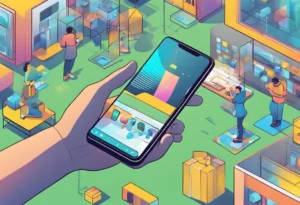
Creating AR content involves designing and developing engaging and interactive experiences that can be viewed through mobile devices or other AR-enabled devices. The process of creating AR content requires a combination of skills such as 3D modeling, animation, image tracking, interactivity, and logic.
3D Models and Animations
One of the most important aspects of creating AR content is the use of 3D models and animations. These models can be created using various software tools such as Blender, Maya, or 3DS Max. Once the 3D models are created, they can be imported into AR software to create interactive AR experiences. By using 3D models, users can create lifelike virtual objects that can be viewed from different angles and distances.
Image and Marker Tracking
Another important aspect of creating AR content is image and marker tracking. This involves using computer vision algorithms to track real-world objects and overlaying digital content on top of them. By using image tracking, users can create AR experiences that are triggered by specific real-world objects. Marker tracking, on the other hand, involves using predefined markers to trigger AR content.
Interactivity and Logic
To create engaging AR experiences, it is important to incorporate interactivity and logic into the content. This involves using triggers, animations, and logic to create interactive experiences that respond to user input. By using triggers, users can create interactive AR experiences that are triggered by specific actions such as tapping on a virtual object. Animations can be used to create lifelike movement and behavior for virtual objects. Logic can be used to create complex interactions and decision-making processes within the AR experience.
Creating AR content involves a combination of skills and techniques such as 3D modeling, animation, image tracking, interactivity, and logic. By using these tools, users can create engaging and interactive AR experiences that can be viewed through mobile devices or other AR-enabled devices.
10 Platforms to create augmented reality
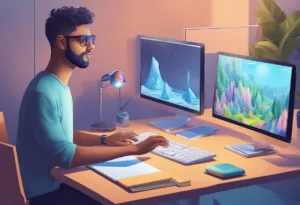
- Adobe Aero
- Overlyapp
- Google ARCore
- Apple ARKit
- Unity
- Unreal Engine
- Vuforia
- Spark AR Studio
- Zappar
- Wikitude
Adobe Aero
Adobe Aero is a platform designed to make augmented reality accessible to creatives without requiring deep technical knowledge. It allows designers to create interactive AR experiences by leveraging familiar Adobe tools and integrating them into the AR creation process. With Adobe Aero, users can bring in assets from Adobe Photoshop or Illustrator and turn them into AR experiences that can be viewed on mobile devices.
Aero includes features like visual programming for interactivity, spatial awareness to integrate digital content with the physical environment, and the ability to share experiences across various platforms. Adobe Aero stands out for its user-friendly interface and integration with the Adobe Creative Cloud suite, making it a go-to choice for designers and artists looking to explore AR.
Overlyapp
Overlyapp is a user-friendly AR platform that enables individuals and businesses to create their own AR experiences without any coding knowledge. It focuses on making AR creation as simple as possible, with a drag-and-drop interface and a variety of templates to get users started.
Overlyapp supports image and object recognition, allowing for interactive print campaigns, educational materials, and more. The platform also offers analytics to track user engagement with the AR content. Overlyapp is particularly appealing to marketers and educators for its ease of use and the ability to quickly deploy AR campaigns or learning materials.
Google ARCore
Google ARCore is a robust platform for building augmented reality experiences on Android devices. ARCore uses three key technologies to integrate virtual content with the real world: motion tracking, environmental understanding, and light estimation.
These capabilities allow developers to create AR apps where digital objects can be placed in the real environment and behave as if they are actually there. ARCore also offers features like shared experiences for multiplayer AR interactions and ‘Augmented Images’ that allow the use of 2D images to trigger AR content. As Google’s official AR development platform, ARCore is continuously updated with new features and is widely supported across many Android devices.
Apple ARKit
Apple ARKit is an advanced AR platform designed for the iOS ecosystem. It provides developers with tools to create high-quality AR experiences for iPhone and iPad users. ARKit includes features like Face Tracking, which enables AR experiences that respond to the user’s facial expressions, and Scene Geometry, which allows developers to create a detailed 3D map of a space.
The platform also supports collaborative sessions, where multiple users can view and interact with the same AR scene. With each iOS update, Apple continues to enhance ARKit, adding more sophisticated capabilities like LiDAR integration for improved depth-sensing.
Unity
Unity is one of the most popular game development platforms that also serves as a comprehensive tool for AR content creation. It offers support for multiple AR development frameworks, including ARKit, ARCore, and Vuforia, making it possible to create cross-platform AR applications.
Unity’s strength lies in its powerful rendering engine, extensive asset store, and supportive community. Developers can create realistic environments, simulate physics, and implement complex animations. Unity also provides a range of tools for optimizing AR experiences for different devices and platforms, ensuring a broad reach for the created content.
Unreal Engine
Unreal Engine is a top-tier game engine renowned for its high-fidelity graphics and real-time rendering capabilities, which are also leveraged for AR content creation. It supports AR development through its integration with ARKit and ARCore, as well as other AR platforms.
Unreal Engine’s visual scripting system, Blueprints, allows for creating complex AR interactions without extensive coding. The engine is equipped with a full suite of creation tools for modeling, animation, and simulation, enabling developers to build immersive and interactive AR experiences. Unreal Engine is ideal for creators who require photorealistic visuals and detailed environmental interactions in their AR projects.
Vuforia
Vuforia is a widely recognized AR development platform that excels in providing advanced computer vision functionalities. It enables developers to create AR experiences that can recognize and track various types of visual markers, including images, objects, and environments.
Vuforia’s key features include Vuforia Engine for robust AR experiences, Vuforia Ground Plane for placing content on horizontal surfaces, and Vuforia Model Targets for using 3D models as markers. The platform supports development for both iOS and Android, as well as integration with Unity. Vuforia is particularly valued for its strong tracking capabilities and support for a wide range of devices.
Spark AR Studio
Spark AR Studio is Facebook’s platform for creating AR experiences that can be shared across Facebook, Instagram, and other apps in its family. It offers a range of tools for both beginners and advanced creators, including face tracking, hand tracking, and object recognition capabilities. Spark AR Studio also provides a library of assets, audio files, and animations to enhance AR projects.
The platform is equipped with features to test and debug AR effects and a straightforward process for publishing them to Facebook’s platforms. Spark AR Studio is popular among social media marketers and content creators due to its direct link to a vast user base.
Zappar
Zappar is a platform focused on making AR, VR, and MR content creation accessible. It provides Zappar Studio for more advanced developers, as well as ZapWorks, which includes tools tailored for educators, trainers, and marketers.
Zappar’s solutions are designed for creating short-form content that can be quickly deployed and experienced through the Zappar app. The platform emphasizes easy-to-use interfaces, rapid content creation, and the ability to track engagement. Zappar is suitable for creating interactive marketing campaigns, educational experiences, and event activations.
Wikitude
Wikitude is an AR platform known for its powerful SDK that offers image recognition, tracking, and geolocation capabilities. It enables developers to create AR apps that can understand and interact with the world in various ways.
Wikitude’s features include 3D model rendering, cloud recognition for scalable content management, and support for multiple development environments, including native APIs for Android and iOS, as well as integrations with Unity and Cordova. Wikitude is aimed at developers looking for a robust and versatile tool to create AR experiences that require advanced environmental understanding and object interaction.
AR Development Tools
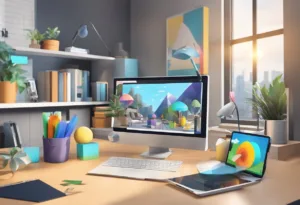
Augmented Reality (AR) is a rapidly growing field that requires a combination of coding skills, creative tools, and software development kits (SDKs). In this section, we will provide an overview of some of the most popular AR development tools.
Software Development Kits (SDKs)
SDKs are essential tools for developers who want to create AR applications. They provide a set of pre-built functions and APIs that enable developers to add AR features to their apps quickly. Some of the most popular AR SDKs include Apple’s ARKit, Google’s ARCore, and Vuforia Engine.
Apple’s ARKit is a popular choice for iOS developers. It provides a set of tools that enable developers to create AR experiences for iPhone and iPad devices. ARKit supports features such as motion tracking, plane detection, and lighting estimation.
Google’s ARCore is an SDK that allows developers to build AR apps for Android devices. ARCore provides features such as motion tracking, environmental understanding, and light estimation. It also supports Unity and Unreal Engine, two popular game engines.
Vuforia Engine is another popular AR SDK that provides features such as image recognition, object recognition, and text recognition. It supports both iOS and Android platforms and can be integrated with Unity, Unreal Engine, and Xamarin.
No-Code Platforms
No-code platforms are ideal for non-developers who want to create AR experiences without writing code. These platforms provide a set of pre-built templates and tools that enable users to create AR experiences quickly. Some of the most popular no-code platforms for AR include ZapWorks, AR Designer, and Torch AR.
ZapWorks is a no-code platform that enables users to create AR experiences using drag-and-drop tools. It provides a set of pre-built templates for AR experiences such as product visualizations, games, and educational content.
AR Designer is a no-code platform that enables users to create AR experiences using pre-built templates and tools. It provides features such as image recognition, 3D object tracking, and video playback.
Torch AR is a no-code platform that enables users to create AR experiences using a web-based editor. It provides features such as image recognition, 3D object tracking, and face tracking.
Creative Tools for AR
Creative tools are essential for developers and designers who want to create 3D models and animations for AR experiences. Some of the most popular creative tools for AR include Xcode, Reality Composer, and Blender.
Xcode is an integrated development environment (IDE) that provides tools for iOS app development. It includes a set of tools for creating 3D models and animations for AR experiences.
Reality Composer is a powerful tool that enables users to create interactive AR experiences without any prior 3D experience. It provides a set of pre-built templates and tools for creating AR experiences such as product visualizations, games, and educational content.
Blender is a popular 3D modeling and animation tool that can be used to create 3D models and animations for AR experiences. It provides features such as 3D modeling, sculpting, and animation.
Designing AR Experiences
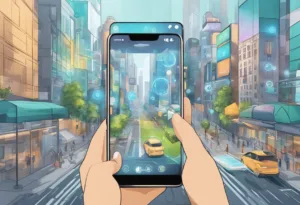
Designing AR experiences require a balance between user engagement and interactivity, face tracking and filters, and immersive storytelling. AR designers must create interactive experiences that are engaging and immersive, ensuring that users are drawn into the experience.
User Engagement and Interactivity
AR content creation starts with designing an engaging and interactive experience. Designers must consider the user’s journey and how they will interact with the AR content. This can be achieved through interactive elements such as buttons, gestures, and voice commands. By providing users with a variety of interactive elements, designers can create a more engaging and interactive experience.
Face Tracking and Filters
Face tracking and filters are popular AR features that have become increasingly prevalent in recent years. Designers can use face tracking to create interactive experiences that respond to facial expressions and movements. Filters can also be used to enhance the user’s experience by adding visual effects and animations to their surroundings.
Immersive Storytelling
Immersive storytelling is a crucial aspect of designing AR experiences. Designers must create a narrative that draws users into the experience and keeps them engaged throughout. This can be achieved through the use of 3D models, animations, and sound effects.
Designing AR experiences requires a balance between user engagement and interactivity, face tracking and filters, and immersive storytelling. Designers must consider the user’s journey and create interactive experiences that are engaging and immersive. By incorporating face tracking and filters, designers can enhance the user’s experience and create a more immersive experience. Finally, designers must create a compelling story that draws users into the experience and keeps them engaged throughout.
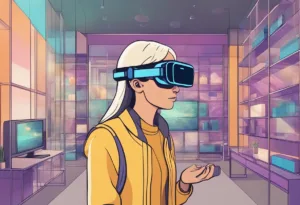
Deploying AR Projects
Deploying AR projects is the final step in the development process. It involves making the project available to users on various platforms and ensuring that it is optimized for performance. This section will cover the following subsections: Mobile and Web AR, Sharing and Distribution, and Analytics and Improvement.
Mobile and Web AR
Mobile and Web AR are two different platforms that can be used to deploy AR projects. Mobile AR involves creating an app that users can download from the app store and install on their mobile devices. On the other hand, Web AR involves creating a web-based AR experience that can be accessed through a browser on a mobile device or desktop computer.
When deploying a mobile AR project, it is important to optimize the app for performance to ensure that it runs smoothly on the user’s device. This can be achieved by reducing the size of the app, optimizing the code, and minimizing the number of assets that need to be downloaded.
For Web AR, it is important to ensure that the experience is accessible on a wide range of devices and browsers. This can be achieved by using a responsive design and optimizing the code for performance.
Sharing and Distribution
Sharing and distribution are key factors when deploying AR projects. It is important to make the project available to as many users as possible to maximize its impact.
For mobile AR, this can be achieved by making the app available on the app store and promoting it through social media and other marketing channels. For Web AR, it can be shared through a link that can be distributed through social media or email.
Analytics and Improvement
Analytics and improvement are important aspects of deploying AR projects. It is important to track user engagement, downloads, and sales to measure the success of the project and identify areas for improvement.
For mobile AR, this can be achieved by integrating analytics tools into the app and monitoring user engagement and downloads. For Web AR, it can be achieved by tracking user engagement through analytics tools such as Google Analytics.
Frequently Asked Questions
What software is needed to develop augmented reality content?
To develop augmented reality content, one needs to have access to specialized software that allows them to create and manipulate 3D models, as well as integrate them with real-world imagery. Some of the popular software options include Unity, Vuforia, ARToolKit, and Wikitude. These software tools are designed to be user-friendly and suitable for both beginners and experienced developers.
What are the costs associated with building an AR application?
The cost of developing an AR application can vary depending on the complexity of the project, the software used, and the level of expertise of the developer. Generally, the development cost can range from a few thousand dollars to tens of thousands of dollars. However, there are several free and open-source platforms available that can be used to create basic AR applications.
How can one become proficient in augmented reality development?
To become proficient in augmented reality development, one needs to have a good understanding of programming languages such as C#, C++, and Java. They should also be familiar with 3D modeling and have experience working with software development kits (SDKs) such as Unity and Vuforia. Attending workshops, taking online courses, and participating in hackathons can help developers improve their skills and gain practical experience.
Are there any free platforms for creating augmented reality apps?
Yes, there are several free and open-source platforms available for creating augmented reality apps. Some of the popular platforms include AR.js, Kudan, and ARToolKit. These platforms offer developers a range of features and tools to create basic AR applications.
What steps are involved in creating augmented reality images?
To create augmented reality images, developers need to follow several steps. First, they need to create or import 3D models into a software tool such as Unity. They then need to use an SDK such as Vuforia to track real-world objects and overlay the 3D models on them. Finally, they need to test the application to ensure that it works smoothly and meets the desired specifications.
Is there a beginner-friendly augmented reality software available?
Yes, there are several beginner-friendly augmented reality software tools available, such as ARToolKit and AR.js. These software tools are designed to be user-friendly and offer a range of features and tools that are suitable for beginners. They offer extensive documentation and tutorials to help developers get started with AR development.


